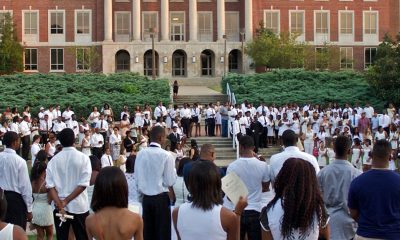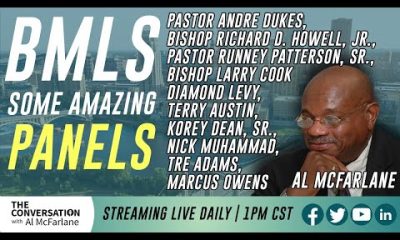Black History
Gates examines period after Reconstruction in new book
FLORIDA COURIER — At the end of the Civil War, Sidney George Fisher, a White gentleman from Philadelphia, declared, “It seems our fate never to get rid of the Negro question.” Although slavery had been abolished, “the problem – what shall we do with the Negro – seems as far from being settled as ever. In fact it is incapable of any solution that will satisfy both North and South.”
By Dr. Glenn C. Altschuler, Special To The Florida Courier
At the end of the Civil War, Sidney George Fisher, a White gentleman from Philadelphia, declared, “It seems our fate never to get rid of the Negro question.” Although slavery had been abolished, “the problem – what shall we do with the Negro – seems as far from being settled as ever. In fact it is incapable of any solution that will satisfy both North and South.”
Between 1865 and 1877, the federal government sought to institutionalize for Blacks “a new birth of freedom,” through military occupation of the South, civil rights legislation, and amendments to the United States Constitution.
Resisted in the North as well as the South, the “experiment” was ultimately abandoned. In the “Redeemed” states of the former Confederacy, sharecropping replaced slavery, Blacks were prevented from voting, and subjected to pervasive, demeaning, violent forms of Jim Crow segregation.
Reconstruction and redemption
In “Stony the Road,’’ Henry Louis Gates, Jr., a university professor at Harvard, prolific author and documentary filmmaker, tells the story of Reconstruction and redemption. A synthesis of scholarly work on race between 1865 and the 1920s, with a focus on literature and visual culture, his book provides a powerful and timely reminder that African Americans have never stopped resisting White supremacy, despite the “unbearably hostile climate it has created.”
Gates documents the myriad ways in which racist ideology infiltrated every aspect of American life.
Well-credentialed scientists “proved” that Blacks were and would remain inferior to Whites, helping justify laws against miscegenation and intermarriage. Proponents of the Civil War as a noble “Lost Cause” insisted that plantation slaves were well-treated and content; during Reconstruction, they maintained, outside agitators unleashed the beasts previously dormant in them.
Intentional images
Images of ignorant, subhuman Sambos, Gates reveals, were ubiquitous in advertisements, consumer products, Uncle Remus stories, children’s games, greeting cards and sheet music. Postcards with photographs of the bodies of Blacks hanging from trees and Whites attending the lynchings were popular as well.
These images, and, of course, scenes from the box-office blockbuster “Birth of a Nation,’’ Gates writes, meant that when a White person encountered a real-live Black, the latter was “an already read text.”
As pseudo-scientists, historians, Supreme Court justices, and Ku Klux Klan vigilantes marched in lockstep to keep Blacks in their place, African Americans fought back to reclaim their rights and their image in what Gates calls “another kind of civil war, a war that was cultural as well as political, a war that featured the concept of “the New Negro.”
Among the disparate individuals and groups creating a counter-narrative to the claims that all Blacks were created unequal were W.E.B. Du Bois and his “Talented Tenth”; writers and poets of the Harlem Renaissance; jazz pioneers; the anti-lynching activists; members of the Niagara Movement and the NAACP.
Still work to do
Eventually, politics took precedence, Gates points out, because many Blacks concluded that cultural constructions without political agency were likely to be “empty signifiers.”
Equally important, Gates seems to endorse the view, held, ironically by both advocates of racial equality and unreconstructed Southerners, that “there never was an Old Negro or a New Negro; there were only Negroes.”
As the poet Sterling Brown proudly proclaimed, African Americans are the legatees of a great people. Not only did they “survive the storm of anti-black racism,” they somehow managed to thrive, create vital and vibrant cultures, “despite the obstacles placed upon them on that stoniest of roads.”
A century later, Professor Gates adds, amidst “ugly language spewed and ugly images strewn, daily across our ever-present screens,” it seems clear that racial justice is incomplete, “frighteningly vulnerable to reversal,” and there is a lot of work to do.
Dr. Glenn C. Altschuler is the Thomas and Dorothy Litwin Professor of American Studies at Cornell University. He wrote this review for the Florida Courier.
This article originally appeared in the Florida Courier.
Activism
Oakland Post: Week of April 24 – 30, 2024
The printed Weekly Edition of the Oakland Post: Week of April 24 – 30, 2024

To enlarge your view of this issue, use the slider, magnifying glass icon or full page icon in the lower right corner of the browser window. ![]()
Activism
Oakland Post: Week of April 17 – 23, 2024
The printed Weekly Edition of the Oakland Post: Week of April 17 – 23, 2024

To enlarge your view of this issue, use the slider, magnifying glass icon or full page icon in the lower right corner of the browser window. ![]()
Black History
Matthew Henson: Explorer Extraordinaire
Matthew Henson, a trailblazing explorer who overcame countless obstacles to leave an incredible mark on history. Born on August 8, 1866, in Charles County, Maryland, his journey is a testament to the power of determination and the spirit of adventure.

By Tamara Shiloh
Matthew Henson, a trailblazing explorer who overcame countless obstacles to leave an incredible mark on history. Born on August 8, 1866, in Charles County, Maryland, his journey is a testament to the power of determination and the spirit of adventure.
Henson’s life began amidst the backdrop of post-Civil War America, where opportunities for African Americans were scarce. From a young age, he possessed an insatiable curiosity about the world beyond his small town. At the age of 12, he embarked on a journey that would change the course of his life forever when he joined a merchant ship as a cabin boy.
His most famous expedition was his journey to the Arctic with renowned explorer Robert E. Peary. In 1887, Henson joined Peary’s crew as a seaman and quickly proved himself to be invaluable with his skills as a navigator and craftsman. Over the course of several expeditions, Matthew endured extreme cold, treacherous terrain, and grueling conditions as he and Peary sought to reach the elusive North Pole.
In 1908–09, Peary set out on his eighth attempt to reach the North Pole. It was a big expedition, with Peary planning to leave supplies along the way. When he and Henson boarded their ship, the Roosevelt, leaving Greenland on August 18, 1909, they were joined by a large group. This included 22 Inuit men, 17 Inuit women, 10 children, 246 dogs, 70 tons of whale meat, blubber from 50 walruses, hunting gear, and tons of coal.
In February, Henson and Peary left their anchored ship at Ellesmere Island’s Cape Sheridan, along with the Inuit men and 130 dogs. They worked together to set up a trail and supplies along the way to the Pole.
Peary picked Henson and four Inuit people to join him in the final push to the Pole. However, before they reached their destination, Peary couldn’t walk anymore and had to ride in a dog sled. He sent Henson ahead to scout the way. In a later interview with a newspaper, Henson recalled being in the lead and realizing they had gone too far. The group turned back, and Henson noticed his footprints helped guide them to their destination. At that location, Henson planted the American flag.
Henson’s legacy extends far beyond his expeditions to the Arctic. He shattered racial barriers in the world of exploration and inspired countless individuals, regardless of race, to dream big and pursue their passions. In 1937, he was finally recognized for his achievements when he was inducted into The Explorers Club, an organization dedicated to promoting scientific exploration and field research.
Matthew Henson died in the Bronx, New York, on March 9, 1955, at the age of 88.
-

 Community2 weeks ago
Community2 weeks agoFinancial Assistance Bill for Descendants of Enslaved Persons to Help Them Purchase, Own, or Maintain a Home
-

 Activism3 weeks ago
Activism3 weeks agoOakland Post: Week of April 3 – 6, 2024
-

 Business2 weeks ago
Business2 weeks agoV.P. Kamala Harris: Americans With Criminal Records Will Soon Be Eligible for SBA Loans
-

 Activism2 weeks ago
Activism2 weeks agoOakland Post: Week of April 10 – 16, 2024
-

 Community2 weeks ago
Community2 weeks agoAG Bonta Says Oakland School Leaders Should Comply with State Laws to Avoid ‘Disparate Harm’ When Closing or Merging Schools
-

 Community1 week ago
Community1 week agoOakland WNBA Player to be Inducted Into Hall of Fame
-

 Community2 weeks ago
Community2 weeks agoThe Year Ahead: Assembly Speaker Rivas Discusses Priorities, Problems
-

 Community1 week ago
Community1 week agoRichmond Nonprofit Helps Ex-Felons Get Back on Their Feet
























































2 Comments